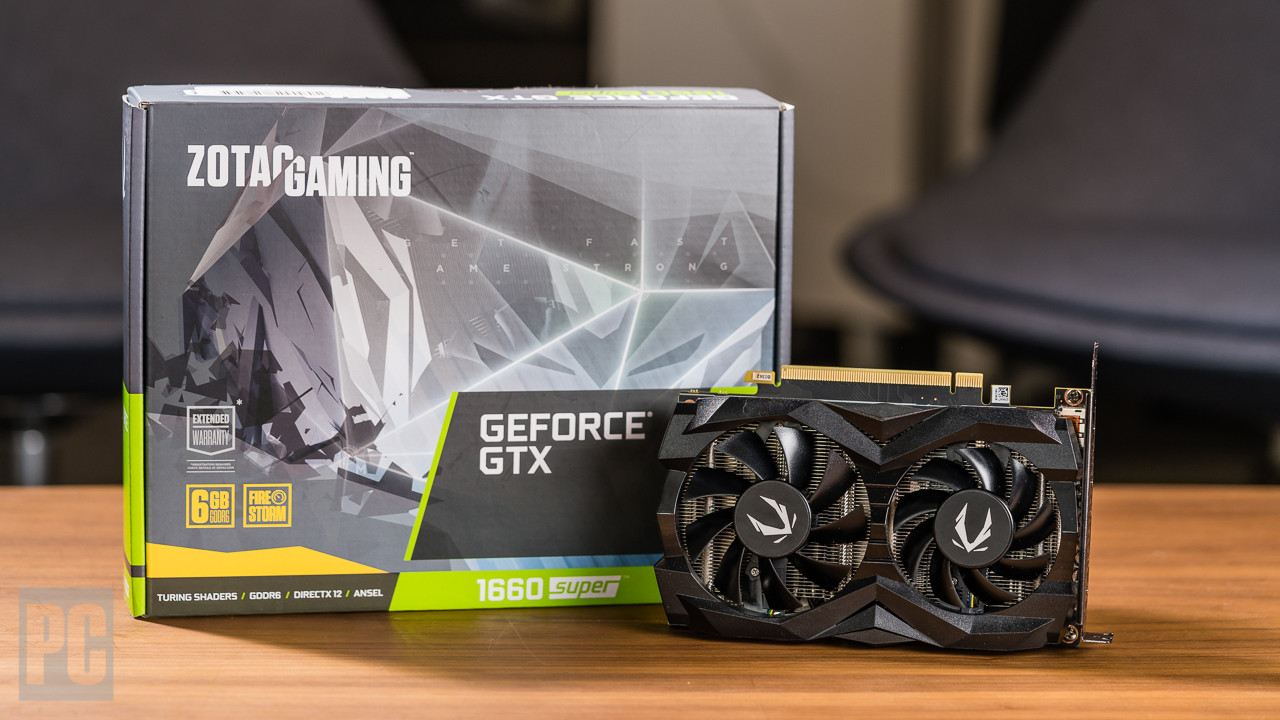Zotac GeForce GTX 1660 Super Twin Fan

The GeForce GTX 1660 graphics card family hasn’t been out for even a year, but it looks like Nvidia’s penchant to “Super”-size all its cards has given it its turn in the Super barrel. As a budget-focused graphics card built for 1080p gameplay, the new GeForce GTX 1660 Super is a tactically priced addition to Nvidia’s swelling lineup of mainstream graphics options. We looked at it in Zotac’s $239 GeForce GTX 1660 Super Twin Fan guise, and while it presents just a modest step up over the non-Super GTX 1660, it still packs enough punch to keep esports hounds and 1080p-bound AAA gamers playing long into the night. It comes in close enough to the next-step-up GeForce GTX 1660 Ti for the price to eke out our Editors’ Choice award for 1080p-gaming cards—for now.
Let’s ‘Super’ All the Things!
First, the question we’re probably all asking: Why? With both a GeForce GTX 1660 Ti and a GeForce GTX 1660 already on the market, many prospective buyers of a mid-priced video card here in late 2019 may find themselves wondering where this new GTX 1660 Super card could possibly fit in.
From a price perspective alone, the GTX 1660 Super line will start at a base of $229 ($10 more than the original GeForce GTX 1660’s introductory price of $219), though the specific Zotac Super Twin Fan we tested will hit shelves for $10 more than that.
The GTX 1660 Super is also the first Super variant we’ve seen from Nvidia in its GTX (as opposed to RTX) line of graphics cards, which is to say, the cards that don’t come with the ray-tracing and DLSS capabilities of the company’s flagship RTX cards. This may open the door for more Supers to start hitting the midrange-to-budget GPU market in the near future. Nvidia has already confirmed one: the GeForce GTX 1650 Super, coming in late November.
All three cards—the GeForce GTX 1660, the GTX 1660 Ti, and the GTX 1660 Super—are based off the “Turing”-architecture TU116 die from Nvidia. Some subtle differences in the memory clocks (and memory types) set apart the top two lines from the standard GTX 1660.
Key Comparisons: Where Does the Super Fit In?
The GTX 1660 Super falls between the GTX 1660 and GTX 1660 Ti on the Nvidia side, and its closest price rival at the moment from Team AMD is the Radeon RX 590. Let’s take a look at how our card sample shapes up against each of those in turn. We’ll be using reference-card specs in the case of each of the GTX 1660 Super’s comparison cards, and the specs for the Zotac card we’re testing.
Nvidia GeForce GTX 1660 vs. GeForce GTX 1660 Super
To set a baseline for how the GTX 1660 Super gains its “super” status, I’ve charted out how the base specs for the non-Super GPU stack up side-by-side against the Zotac version of the Super.

As you can see, nearly every aspect of the original GeForce GTX 1660 remains unchanged in the upgrade to the GTX 1660 Super aside from one core element: the memory type and clock. The GTX 1660 Super upgrades the original GTX 1660 from GDDR5 memory to GDDR6, while nearly doubling its clock speed from 8Gbps to 14Gbps.
Nvidia GeForce GTX 1660 Ti vs. GeForce GTX 1660 Super
Less clear at first glance is the difference between the GTX 1660 Ti and the GTX 1660 Super, since both would seem, by definition, to be forms of up-ticked GTX 1660 cards…
–

Despite having a lower base and boost clock speed, the GTX 1660 Ti is still the more powerful card of these two, thanks to its 128 extra CUDA cores. The GTX 1660 Ti also does more with slightly less power, at a 120-watt requirement, while the GTX 1660 Super needs 125 watts (in the version we tested). That’s a trivial difference, though.
AMD Radeon RX 590 vs. Nvidia GeForce GTX 1660 Super
Finally, here is how the GTX 1660 Super tested here stacks up against the closest AMD equivalent: the Radeon RX 590.
–

On specs alone, it’s a little tough to put these two alongside one another, but on both price and performance (as we’ll discuss in more detail below), the Radeon RX 590 is the closest AMD equivalent on the market right now. The RX 590 is built on the latest refinement of AMD’s older “Polaris” architecture, and with cards based on AMD’s new-generation, 7nm “Navi” technology filtering out, I suspect this dynamic may change in the coming months. AMD, for example, has already announced a Radeon RX 5500 for later this year, though details are scarce.
Our First ‘Super’ Sample: A Look at Zotac’s Twin Fan
As a graphics card that’s priced as solid midrange material, we weren’t expecting a whole lot of flash out of Zotac’s GeForce GTX 1660 Super Twin Fan, and that’s exactly what we got after we opened the box…

Aesthetically speaking, this double-slot-width card looks similar to any other card in the Zotac Twin Fan family, with a black plastic shroud that holds two fans inside a housing that measures 6.8 inches long. That’s small by most card standards, and plenty petite enough to fit in many compact builds, if you so choose.
The back of the card has three DisplayPort 1.4b ports and one HDMI 2.0 port. (Sorry VirtualLink hopefuls; you’ll have to connect your VR headset the old-fashioned way on this one.) Also absent is DVI, in the event you have an older monitor…
As for power delivery, you’ll need a single eight-pin power lead off a power supply with enough headroom to deliver 125 watts.
Souped Up, But Just Slightly Faster
PC Labs ran through a series of DirectX 11- and 12-based synthetic and real-world benchmarks on the Zotac GeForce GTX 1660 Super Twin Fan. Our test rig is equipped with an Intel Core i7-8700K processor, 16GB of G.Skill DDR4 memory, a solid-state boot drive, and an Aorus Z370 Gaming 7 motherboard.
For our benchmark results we wanted to focus some of our efforts on the esports aspect of the GTX 1660 Super’s abilities, as much of the press from Nvidia has centered around its ability to push 1080p multiplayer games to their highest-possible frame rates.
Related Story See How We Test Graphics Cards
We also ran it through our standard video-card benchmarks, which test a card’s abilities to handle AAA games at the highest possible quality settings. With the GTX 1660 Super being the budget-to-midrange card it is, we weren’t expecting it to smash any records in this department and graded it with that consideration in mind.
Synthetic Benchmarks
Overclocking & Thermals
Being a Super card can sometimes mean the headroom for overclocking is reduced, since the Super variants already represent the top-end of the power curve a particular GPU die is capable of handling. But there was some surprise in store here: The Zotac 1660 Super Twin Fan was able to stay stable during our overclocking tests well past where I thought it would start to wobble.
I was able to achieve a stable OC of +175MHz on the boost clock, and +250MHz on the memory clock, representing a boost of roughly 11 percent across the board. As is usually the case, this 11 percent gain in clocks didn’t translate directly to an equal raise in performance, but it was nonetheless still close.
In testing Far Cry 5 both in and out of the overclock, I saw a performance boost of just over 9 percent in 1440p and 1080p testing, while the benchmarking tool 3DMark saw gains ever-so-slightly lower, at 8.5 percent.
Next, to test the thermals of the Zotac GeForce GTX 1660 Super Twin Fan, I ran the Fire Strike Ultra Benchmark Stress Test for 10 minutes, and recorded the results in GPU-Z.
During that period, the card maxed out at 73 degrees C, off a resting idle temperature of 34 degrees C. This makes sense when you consider that the card now has a higher memory bandwidth to keep cool, and the original GeForce GTX 1660 came in just under that figure at 71 degrees C in the same test, in the same case.
–

The FLIR One Pro thermal imaging test showed most of the waste heat generated by the card being collected around the backplate, with a smaller amount being ejected out the back of the case via the rear-facing vents.
Slicing the 1660 Cards Super-Fine, But Still Solid
So, that’s a lot of data. The big question is what it adds up to: Did we really need the GeForce GTX 1660 Super, whether in Zotac Super Twin Fan form, or any form?
Maybe not. But I’m happy to have it as an option in the mainstream-card aisle, nonetheless. The GeForce GTX 1660 Super represents a card that will reliably return strong 1080p high-refresh gaming results, and scratch the surface of some titles at 1440p, while still giving the GTX 1660 Ti enough of a mandate to exist.
There’s no word from Nvidia on whether the original, non-Super GTX 1660 will be discontinued. Consider, though: Right now, the MSRPs for the GTX 1660 and the GTX 1660 Super are only $10 apart in their base-card form, at $229 for the GTX 1660 Super against $219 for the GTX 1660. And our Zotac representative card is just $10 atop that. At this price, there’s almost no reason not to get the GTX 1660 Super over the Non-Super.
In sum, this card bridges budget and mainstream pricing, and it’s made to play most esports titles above 144fps in 1080p and AAA games at more than 60fps at 1080p. If that suffices for your gameplay (and it should for the lion’s share of PC owners), Zotac’s GeForce GTX 1660 Super Twin Fan handles the job admirably. Until, perhaps, AMD answers with a “Navi” Radeon DNA-based card at a similar price—or Nvidia splices even more Super cards into the GeForce line—in its price band it’s the best bargain in town.
Bottom Line: If you’ve been holding off on a mainstream video card for 1080p gaming, the GeForce GTX 1660 Super could be your trigger to buy: It’s a solid-playing, popularly priced waypoint between the GTX 1660 and GTX 1660 Ti.




